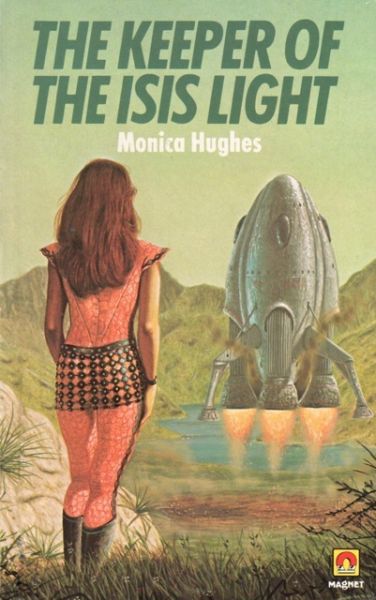So Said The Lighthouse Keeper
The Keeper of the Isis Light (Isis, volume 1)
By Monica Hughes

20 Aug, 2017
Because My Tears Are Delicious To You
0 comments
1980’s The Keeper of the Isis Light is the first volume in Monica Hughes’ Isis Trilogy.
Olwen Pendennis has been the keeper of the Isis FTL beacon ever since she was an infant, an infant orphaned by calamity on distant Isis. For her, life with no human companions is perfectly normal. After all, she has her wise robot Guardian to advise and keep watch over her, her amiable but formidable-looking Hairy Dragon Hobbit for company, and an entire planet to call her own.
On her tenth birthday — sixteenth by Earth years — her life changes forever.
Isis is a class B — marginally habitable — world orbiting an F5 star five parsecs from Earth. In the past, colonization efforts have focused on class A worlds closer to the Solar System. Now a ship is on its way to Isis, a colony ship filled with an unimaginable multitude of settlers. Olwen has never seen another human. Now she will have to find some way to co-exist with eighty of them.
Olwen would be happy to let Guardian deal with the settlers. For some reason the settlers insist on interacting with another human. Guardian has no choice but to honour the colonists’ preferences … and so the ten-year-old finds herself thrust into a position of considerable responsibility.
The initial stages of colonization go well. In fact, there is an unexpected benefit from Olwen’s point of view: she meets and falls in love with Mark London, a teenager whose family risked the dangers of interstellar travel to settle on Isis. There’s just one impediment to their young love: Olwen’s environment suit.
Hyper-cautious Guardian insists on equipping Olwen with an environment suit to wear whenever she meets with the settlers, ostensibly to protect her from unfamiliar diseases. No part of her is exposed when she wears it. As a result, she and Mark have never held hands. He has never even seen her face.
The day he does finally see her will change both of their lives forever.
~oOo~
Cover artists have a tricky task where Keeper is concerned, because ideally one wants the protagonist on the cover but Olwen’s appearance is a spoiler for certain aspects of the plot. While she wears an all-concealing environment suit, artists appear to prefer not to draw that. Instead, they either pose Olwen so her face is not visible:



Or they depict her as a white girl.


One has to feel sorry for the poor robot Guardian, who will never been seen as anything but property, even though he’s smart enough to come up with a very ingenious way to obey his conflicting directives. The lot of intelligent robots in SF is often a lamentable one.
Unlike all too many authors, Hughes has set her coming of age story in a very specific place: a slightly-larger-than-Earth world, with an atmosphere somewhat thinner than Earth’s, and which orbits a brighter and more active star. These details shaped the story: the altitude above which humans cannot survive is low compared to Earth, which puts most of the mountains around the colony off limits for anyone without special equipment. Also, the active star is prone to solar flares. It is an ongoing threat for anyone unlucky enough not to be sheltered when it acts up (this is why Olwen is an orphan). Hughes is so particular about the Ra system that it seems as if she had a specific star in mind. It was somewhat of a disappointment to find that there does not seem to be an F5 star five parsecs from Earth in the constellation Indus1.
This is set in a fairly stock universe for 80s SF. Earth is overcrowded, despite draconian population controls. Crowding, shortages, and regimentation have not made it a complete dystopia; people are making do, making the best of what they have.
Habitable worlds are common enough that some are found within a few parsecs of Earth. However, in this setting, “habitable” includes marginally acceptable worlds that are settled only because better worlds have already been taken.
The new settlers on Isis seem to be mostly white. There is perhaps one black family of note on Ra. Olwen saves their all too bold and curious little boy from an awful fate and casually refers to him as “Negroid.” Hmm. In a 1980 book? That usage would have been somewhat antiquated and deprecated even then2. Presumably she learned it from Guardian. Who programmed him?
Thanks to Guardian’s bold solution to the problem of keeping an infant alive on a hostile world, Olwen is even more unusual than that one black family. Interestingly, the novel doesn’t take the view Love Will Overcome; it’s quite possible that Love Will Only Make It All Much More Complicated. Poor Olwen: Guardian protected her against the local challenges but did a very poor job of preparing her to deal with other humans.
Despite the fact that the Hughes might better be described as an expat Brit (she was born in Liverpool in 1925 and died in Edmonton in 2003; she also lived in Egypt and Zimbabwe) she is usually described as a Canadian author. Well yeah; it’s a rather melancholy coming-of-age novel. CanLit isn’t just about fucking bears; a lot of it revels in avoidable loss and sudden tragedy.
At least this story isn’t as tragic as Romeo and Juliet.
The Keeper of the Isis Light is available here (Amazon) and here (Chapters-Indigo).
1: Also, the scale height (the rate at which air pressure drops off) seems inconsistent with a higher gravity.
2: Although I seem to recall even more archaic lingo in A. Bertram Chandler so perhaps this is a British versus New World usage issue.
